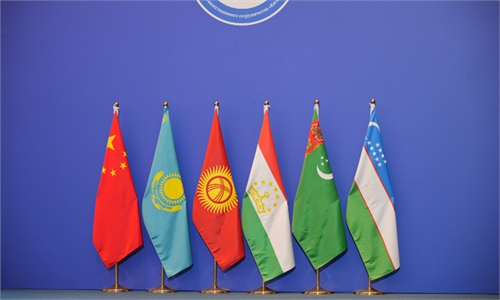Interconnectivity helps C.Asian countries break landlocked bottleneck, unleash economic and trade potential

Illustration: Chen Xia/Global Times
China's Foreign Ministry on May 8 announced that the China-Central Asia Summit will be held on May 18 and 19 in Xi'an, Northwest China's Shaanxi Province. This is China's first major diplomatic event this year, also the first in-person summit among the heads of state of the six countries over the 31 years since China established diplomatic relations with these countries. It is of milestone significance in the history of the relations between China and Central Asian countries.
China and Central Asian countries are good neighbors, good partners, good friends, and good brothers who share a common future. The convening of the first China-Central Asia Summit will help deepen regional economic and trade cooperation, break the development bottleneck of landlocked countries in Central Asia, and inject new impetus in building a closer China-Central Asia community with a shared future.
First, breaking the development bottleneck of Central Asian countries. The five Central Asian countries are all landlocked countries. The interconnectivity facilitated by the Belt and Road Initiative (BRI) provides these countries with opportunities to tackle the challenges encountered in development and helps diversify the economies of these countries, which are mainly dependent on the export of raw materials.
Over the past ten years, cooperation between China and Central Asia under the BRI has achieved a series of noteworthy benchmarks. China's support for the construction of major infrastructure projects such as the China-Kyrgyzstan-Uzbekistan highway and the China-Tajikistan highway has greatly promoted the interconnection and development of the Central Asian region.
Moreover, Central Asian countries share a single economic structure and urgently need to diversify and improve their economic security. For this reason, in the process of economic and trade cooperation with Central Asian countries, China actively supports the construction of new energy projects in Central Asian countries and promotes local development. Energy transformation and diversified development continue to unlock the development bottlenecks of Central Asian countries and promote independent development.
Second, improve the trade development capacity of Central Asia. Under the BRI, trade rules between China and the five Central Asian countries are gradually being connected. Through improving inspection and quarantine and customs clearance capabilities, trade liberalization and facilitation of the five Central Asian countries has been continuously improved. Meanwhile, the production capacity cooperation between China and the five Central Asian countries is also of great significance for the five Central Asian countries to participate in global value chain cooperation.
For example, projects like the Zhongtai Dangara Agriculture and Textile Industrial Park jointly built by China and Tajikistan, a key project for China-Kazakhstan production capacity cooperation - a factory opened by Golden Camel Group in Kazakhstan's Turkistan industrial zone to produce camel milk powder and the China-Shanghai Cooperation Organisation (SCO) Agricultural Base and China-Uzbekistan Modern Agricultural Science and Technology Demonstration Park have greatly boosted trade between China and the five Central Asian countries and further optimized the trade structure.
In 2022, bilateral trade between China and the five Central Asian countries reached $70.2 billion, a year-on-year increase of about 40 percent, hitting a record high, and direct investment continued remaining stable. In the first two months of 2023, the trade between China and Central Asia increased by 22 percent year-on-year, showing a strong momentum of development. In 2022, China's imports of agricultural products, energy products, and mineral products from Central Asian countries all increased by more than 50 percent year-on-year, exports of mechanical and electrical products to Central Asian countries increased by 42 percent year-on-year, and cross-border e-commerce trade between China and Central Asia increased by 95 percent year-on-year.
Third, promoting regional security cooperation. The SCO established in 2001 by China, Kazakhstan, Kyrgyzstan, Russia, Tajikistan, and Uzbekistan, was the first inter-governmental organization named after a Chinese city, aiming to strengthen multilateral cooperation and maintain regional peace and security. In recent years, instability across the Eurasian continent has impacted all regional countries. Although riots and conflicts broke out in Central Asian countries many times, the overall situation in the region has remained basically stable.
With the US withdrawing troops from Afghanistan and the conflict between Russia and Ukraine leading to regional geopolitical tensions, China and the five Central Asian countries share a strong willingness to maintain regional peace and stability through strengthening cooperation and reduce insecurity and instability in the region.
Except for Turkmenistan, which is a neutral country, the other four Central Asian countries are all founding members of the SCO. Against this background, the China plus five Central Asian countries (C+C5) cooperation mechanism came into being. Compared with the SCO, the C+C5 cooperation mechanism not only covers all Central Asian countries, but also can focus more on Central Asian affairs. It is expected that China and Central Asian countries will carry out more security cooperation in the future.
The current geopolitical instability and uncertainty of the global economic recovery are still fermenting. China and the five Central Asian countries need to strengthen solidarity and cooperation more than ever. The China-Central Asia Summit to be held in Xi'an is a milestone in the history of the development of relations between China and Central Asian countries, and will certainly help strengthen the strategic mutual trust and development cooperation foundation between China and Central Asia.
The author is professor with School of International Relations and Diplomacy, Beijing Foreign Studies University. bizopinion@globaltimes.com.cn


